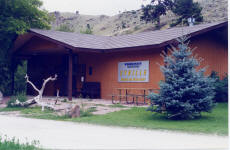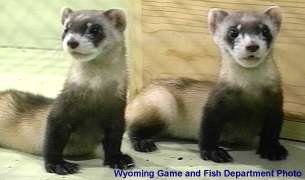
is located on Highway 34 about 35 miles southwest of Wheatland and 45 miles northeast of Laramie.
Sybille's Beginning:
In 1948, the Wyoming Game and Fish Department purchased
3,081 acres of land, known at the Johnson Creek Wildlife Habitat Management
Area to serve as winter range for mule deer and to provide the public with
recreational opportunities. To address the needs for wildlife research, a
field research facility needed to be developed to work with the Department's
research laboratory at the University of Wyoming. The Johnson Creek WHMA
purchase was ideal for developing such a research facility. It provided easy
access, adequate space for pastures and confinement areas, and possessed
diverse terrain, cover and weather conditions. Its proximity to the
University and supporting facilities also made its location optimal. The
development of the research facility began in 1952 under the direction
of Floyd Blunt and continues today.
Leading
the Way in Wildlife Research:
Sybille was the first facility of its kind and
remains one of the country's leading state wildlife research facilities. It
is not a game refuge or preserve. Activities and projects at Sybille are
specialized and of a practical nature rather than research for research
sake. Studies at Sybille are keyed to the needs of game and habitat
management and organized to answer questions and develop techniques that can
be directly applied to wildlife management in the state. Past, present, and
future studies include wildlife diseases such as brucellosis, chronic
wasting disease and pasteurellosis (pneumonia) in bighorn sheep, endangered species capture and propagation, nutrition,
physiology, and genetics. Efforts are continuously being made to develop
improved handling, anesthesia, and general wildlife techniques. Sybille has
contributed more than 170 research projects to conservation since its
founding in 1972.
|
Captive elk with chronic wasting disease |
Brucellosis research at Sybille Wildlife Research Unit |
At the Forefront of Endangered Species Research:
The effort to serve the black-footed ferret,
Mustella negripes, has been a long and cooperative process between state
and federal agencies. The first ferrets were taken into captivity in 1971 by
the U.S. Fish and Wildlife Service, however, some died of vaccine-induced
canine distemper, some of old age and none were successfully bred. The
discovery of the black-footed ferrets in Meeteetse, Wyoming in 1981 offered
a new ray of hope. The Wyoming Game and Fish Department initiated their own
captive breeding program in 1987 after a 1985 outbreak of canine distemper
almost wiped out the population. Although the ferrets were bred
successfully, the first few years were a learning process. Biologists had
much to learn about reproduction, behavior, and ways to prevent lethal
diseases such as canine distemper and sylvatic plague. Success came quickly
to the program and by 1989 the population was divided and sent to
participating institutions to insure that disease would not wipe out the
entire population at once. The Sybille captive breeding program has brought
the ferret back from the brink of extinction. The population grew from its
meager beginnings of 18 ferrets taken from the wild to over 300 ferrets,
some of which are now being returned to the wild in an effort to renew
sustained populations. Zoos and institutions all over the country now
maintain breeding populations of black-footed ferrets. In 1996, the USFWS
took over the program continuing the ongoing effort to save the black-footed
ferret.
brought
the ferret back from the brink of extinction. The population grew from its
meager beginnings of 18 ferrets taken from the wild to over 300 ferrets,
some of which are now being returned to the wild in an effort to renew
sustained populations. Zoos and institutions all over the country now
maintain breeding populations of black-footed ferrets. In 1996, the USFWS
took over the program continuing the ongoing effort to save the black-footed
ferret.
Sybille Wildlife Research & Conservation
Education Unit
2362 Highway 34
Wheatland, Wyoming 82201
(307) 322-2571
Document URL: https://WGFOAPPS.WYO.GOV/accessto/regional/sybille.asp
Last Modified: March 4, 2002